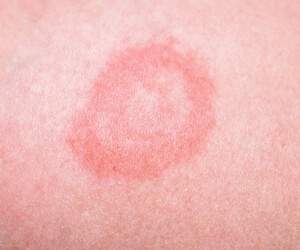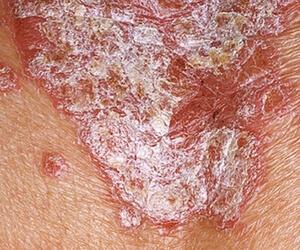Psoriasis is characterized by remission and worsening periods. Skin inflammation is divided into several stages: initial, progressive, static, and regression. This separation will facilitate diagnosis and appropriate treatment.
The interesting thing is
Psoriasis is a genetic disease. Approximately 10% of the population suffers from characteristic DNA diseases, and only 2% of them show signs of abnormal skin function.
The following factors cause the appearance of pathology:
- Severe emotional stress;
- Injured;
- Alcoholism, smoking;
- Unbalanced diet;
- Infectious diseases and other diseases;
- Certain drugs;
- Endocrine diseases;
- Prone to allergies;
The first symptoms of the disease appeared due to a wrong reaction of the immune system (a foreign body reaction to the epidermal tissue). Consider the stages of psoriasis, its symptoms and treatment options.

The initial stage of psoriasis
The first symbol isthe appearance of the pimples(mound-shaped). Round, reddish or pink. In the lower extremities, a blue tint may appear due to the slow flow of blood. The formation of papules is very small, only the size of a needle.
The early stage is characterized bymany papules, their boundaries are clear. A white scale appears. They are easily separated from the surface by touch. Babel can be combined into one to form larger elements.
During the early remission, the rash becomes pale. The affected area of the skin will be partially discolored. In children, this stage of psoriasis is often confused with manifestations of allergies or texture. The rash may be accompanied by severe itching. Signs that can be used to diagnose psoriasis:
- When scratched, the surface of the plaque becomes white, similar to a drop of rubbed stearin, and the scales peel off;
- If you continue to scrape the stains and remove the limescale, a shiny red surface will appear;
- A small drop of blood will appear when scratched.
Stages of development of psoriasis
In the development stage of psoriasis, the following symptoms appear:
- Papua turns red and continues to be covered with white scales. They can be peeled off easily and a smooth red skin layer can be seen under them. Blood will appear when damaged.
- As the disease worsens, the elements of the pimples grow and merge. They are clearly different from healthy skin areas.
- Itching worsens. But it passes in the process of transitioning to a fixed stage. Pain and compulsive itching can interfere with sleep and daily activities. If you just scratch the shell, injuries and new patches will appear. The appearance of new plaque on the injured site is Cobbner's syndrome. The number of itching manifestations gradually increased, covering the body, limbs, and head.
- There are no scales on the edges of the plaques. They are hyperemic, indicating the continuation of the inflammatory process.
Consequences
Psoriasis may negatively affect the joints (psoriatic arthritis). If not treated, the joints will suffer severe pain and deformation.
Fixed period of psoriasis
The main characteristic of stable psoriasis is that new elements cease to appear. The right treatment is accompanied by positive changes.

Clinical manifestations:
- The itching disappears;
- No injury (Koebner symptoms disappear);
- Flaking may increase.
All spots stop developing. If in the advanced stage, there are no scales on the edge of the plaque, then in the stationary stage, the inflamed surface of the entire covering layer will peel off and it will get the typical psoriasis appearance.
Scales are characteristic of the last stage of inflammation. At the beginning of pathological development, the scales cannot keep up with the gradual growth of the plaque, nor can they completely cover the plaque. In half of the cases,pseudo-shrinking corollawill appear.
Fake shrunken corolla
looks like a shallow border around the element, and its structure is reminiscent of rough thin paper, which is composed of cuticles and does not exceed 2 mm in width.
The degenerative period of psoriasis
In the subside phase of psoriasis, the psoriasis cycle ends. Outstanding features:
- The plaque gradually dissolves;
- The peeling stops and the components of the rash become flat;
- The rash turns pale pink and gradually changes color.
- Papules may still remain on the arms and elbows.
There is no scarring or atrophy in the affected area. In the area of the rash, there may be temporary pigmentation or areas with no pigment.
Remission after complex treatment.The relief period is personal. The underlying disease may last for months or even years. Except for only a few forms of psoriasis, winter attacks are more frequent.
Treatment of psoriasis in different stages
The treatment of any form of psoriasis includes general and topical treatment, physical therapy and dietary adjustments. In the early stages of treatment, it is necessary:
- Give up bad habits;
- Strictly follow the therapeutic diet;
- Use ointments containing vitamin A, D3 and hormones;
- Use systemic and sedative drugs;
- Receive UV treatment.
If the plaque is on the head, the doctor will prescribe a shampoo based on tar, zinc, and selenium sulfide.
All funds must be used under the guidance of a doctor. Long-term use of drugs (especially tar) can irritate the skin. Funds should be replaced every 7 days.
Early psoriasis treatment
The effectiveness of early treatment interventions depends on when the patient sees a doctor and starts treatment.
In most cases, early treatment can help prevent the disease from turning into a chronic disease.
Experts recommend using salicylic acid ointment. It is an anti-inflammatory and antibacterial drug that has a beneficial effect on the affected skin area. With the help of keratolytic action, the ointment will cleanse the plaque covering the keratinized part.Naphthalene ointment will help relieve itching.
Usually prescribed drugs:
- Based on tar;
- Based on solid oil;
- Oil base.
Psoriasis drops and grease appeared not long ago. This tool can soothe the skin, moisturize, prevent dry skin and relieve puffiness. The preparation contains ubiquinone, β-carotene, beaver fat, propolis, pumpkin seed oil and other ingredients. With these ingredients, the number of plaques is reduced, becomes fewer, and the skin is more hydrated. It is recommended to use it in combination with other medicines and consult with experts.
Treatment of progressive psoriasis
The treatment method should be comprehensive and cautious. The clinical situation is quite difficult, and treatment should only be trusted by experts. Intravenous and intramuscular injection of special drugs can help patients. Absorbent helps to remove toxins from the body.
It is expressed as a salicylic acid ointment and moisturizer. They moisturize and reduce inflammation. During the exacerbation period, drugs containing tar or other irritating ingredients in the composition should not be used.
During the period of reducing inflammation, it is best to perform physical therapy procedures (PUVA treatment, ultraviolet radiation, paraffin application). Corticosteroids and cytostatics are prescribed only when the process is particularly complicated.
Prescribe antihistamines (to reduce the development of allergic reactions), tranquilizers (soothing), anti-inflammatory drugs, keratolytics (emollients), diuretics (to relieve swelling, remove toxins).
Treatment of stable psoriasis
The patient needs minor correction. Usually prescribing tar shampoo, oil and emulsifying calcitriol emulsion. When the disease affects a large area of the skin, systemic therapy should be used. Ultraviolet radiation and PUVA technology are widely used.
If there is no effect, you need to prescribe some cytotoxic drugs. In severe cases, cytostatic immunosuppressants are prescribed to patients.
Treatment of psoriasis during regression
The treatment of end-stage psoriasis should be fully adjusted by experts. Treatment is gradually cancelled and replaced by preventive measures. All stages of treatment are carefully handled, and the rash must not be damaged.
It is especially important to observe the strictest diet and correct lifestyle. Stress can be a powerful stimulus, which can severely aggravate the condition during the onset.
In combination with medication, you can treat rashes on your hands with sea salt baths or baby creams mixed with a series of powders, and use this mixture to lubricate plaques.
Other therapies
Psoriasis patients lack vitamins, vitamins affect the regulation of metabolic processes, and have blood purification, sedation and recovery effects.
The vitamin complex should contain B vitamins, ascorbic acid, vitamin A, folic acid, etc. They are prescribed internally, intramuscularly and in the dropper.
Dividing pathology into different stages is a conditional measure that can help experts correctly identify one stage or another, and promote diagnosis and treatment. It is impossible to completely get rid of psoriasis, but if you follow all the comprehensive treatment rules and take systematic preventive measures, the disease may remain latent for a long time and will not interfere with human life to the greatest extent.























